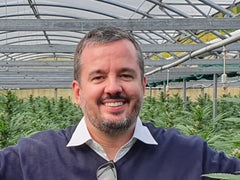Unveiling the power of non-psychoactive cannabis
Industrial hemp has long been recognised as a versatile agricultural asset. Modern nations are investing heavily in research, often funded by taxpayers, with the aim of unlocking more sustainable agricultural practices.
The US Department of Agriculture recently expressed its enthusiasm for a new super plant with a unique genetic makeup, characterised by exceptionally low levels of cannabinoids such as Tetrahydrocannabinol (THC) and Cannabichromen (CBC).
The vision: Robust hemp for diverse applications
The primary goal is to cultivate a consistently stable and healthy plant devoid of intoxicating components. This would pave the way for robust hemp varieties that can be efficiently transformed into textiles, fuel, or construction materials.
The reintroduction of non-psychoactive cannabis to the fields marks a significant shift. For decades, even licensed hemp farmers lived in fear of potential police raids that could destroy their entire harvest based on mere suspicions.
With the gradual legalisation of cannabinoids, both consumers and producers stand to benefit. Cannabis is merely reclaiming its ancient status as a flexible staple, serving humanity as clothing, medicine, and more.
Challenges in commercial cultivation
While the vision is promising, large-scale commercial cultivation presents its own set of challenges. Concerns range from potential cross-pollination issues to disputes over patent rights for specific strains.
Regulatory bodies are also wary of potential pest infestations that could jump from cannabis to other crops. The soil's health, especially concerning fertilisers, is another area of scrutiny.
However, recent research breakthroughs have led to the development of strains that encapsulate the desired traits. These genetically enhanced hemp plants exhibit normal metabolism, grow as vigorously as traditional variants, and are resistant to common pests.
US agriculture’s progressive stance on hemp
The US Department of Agriculture has been progressively focusing on industrial hemp as a crop with immense potential. Comprehensive guidelines for cultivation were released in early 2023. Adjusted THC limits, reduced bureaucratic hurdles, and clear state-provided information are some of the highlights of these guidelines.
Furthermore, American farmers can directly approach government agencies for official support, especially if they aim to extract CBD oil from industrial hemp. While Europe grapples with bureaucratic red tape and ideological barriers, the US recognises the unparalleled potential of cannabis and is keen to harness its benefits.
Subsidies and reduced bureaucracy fuel the hemp boom
Despite the progressive stance in North America, the journey towards normalising hemp cultivation has been arduous. In 2022, the cannabis industry's revenues from industrial hemp, referred to as "Hemp" in English, witnessed a decline. This was primarily attributed to the lack of clear regulations, leading to hesitancy among investors.
While the US has made significant strides, Europe continues to lag. European regulations for cannabinoids are as convoluted as the bureaucratic machinery in Brussels. In contrast, China, despite its stringent stance on recreational marijuana use, recognises the economic potential of non-intoxicating hemp strains. The country is ramping up its cultivation efforts, eyeing the lucrative export market, especially to the US.
Genetically enhanced cannabis: A game-changer
The recent unveiling of genetically enhanced cannabis strains could redefine the dynamics of global trade and agriculture. These strains promise greater sustainability, reduced dependency on pesticides, and a potential shift towards eco-friendly energy sources and sustainable food production.
As trade wars and systemic competitions intensify, these new cannabis strains could offer nations a degree of self-reliance, reducing dependency on imports. Whether it's sustainable energy or home-grown food, the future of agriculture might very well be intertwined with the destiny of this versatile plant.






